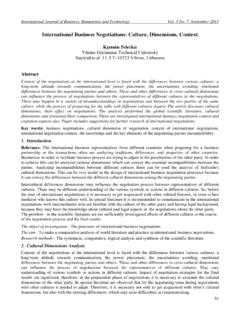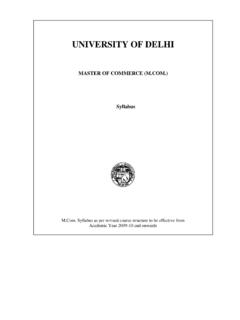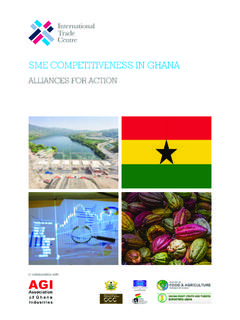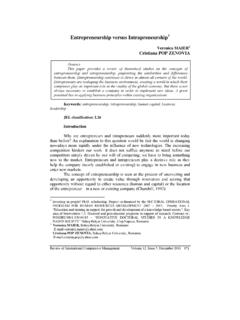Transcription of Business Environment - ITC evaluation
1 evaluation of International Trade Centre Volume 4 ITC Products Business Environment File No. April 2006 DMI ASSOCIATESin association withTicon DCAC openhagen DCAce Global Business Environment TABLE OF CONTENTS 3 Table of Contents List of 1 Business Environment .. 5 5 World Tr@de Net ..13 Business for Development ..32 Standards and Quality Management ..38 Export Legal Framework for Foreign Trade ..56 Executive Forum and Export International Purchasing and Supply Chain Management ..78 Boxes Box 1: Members of World Tr@de Net Box 2. Website hits Tables Table 1: Staffing of Business Advisory Services, International Purchasing and Supply Chain Management, and Executive Forum Table 2: Publications of World Tr@de Net: ITC E Shop Sales Statistics (2004) Table 3: Publications of World Tr@de Net: ITC E Shop (1 Quarter 2005) Table 4: Comparison of Internet Usage for Selected Trade Websites Table 5: ITC E-Shop Sales Statistics (2004) Table 6: ITC E-Shop (1 Quarter 2005) Table 7: ITC E-Shop Sales Statistics (2004) Table 8: ITC E-Shop (1 Quarter 2005) Table 9: ITC E-Shop Sales Statistics (2004) Table 10: ITC E-Shop (1 Quarter 2005) Table 11: ITC E-Shop (1 Quarter 2005) Table 12: List of Network Members Table 13: ITC E-Shop Sales Statistics (2004) Table 14: ITC E-Shop (1 Quarter 2005) Annexes Annex 1.
2 Survey of World Tr@de Net Partners Annex 2: Survey of Participants in the Business for Development Forum in Rio de Janeiro Annex 3: Survey of the Utilization of ITC Products Related to Standards and Export Quality Manage-ment Annex 4: Survey of ITC Partners on Packaging Business Environment LIST OF ACRONYMS 4 List of Acronyms CIS Commonwealth of Independent States DTCC Division of Technical Cooperation Coordination DTSS/BAS Department of Trade Support Services/ Business Advisory Services DTSS/IPSMS Department of Trade Support Services/International Purchasing and Supply Management Section EU European Union GATS General Agreement on Trade in Services IPSCM International Purchasing and Supply Chain Management IPSM International Purchasing and Supply Management ISO International Organisation for Standardization1 ITC International Trade Centre JITAP Joint Integrated Technical Assistance Programme MIGA Multilateral
3 Investment Guarantee Agency MLS Modular Learning System OAS Organisation of American States OED Office of the Executive Director OHADA Organization for Harmonization of African Business Law PACkit Integrated Export Packaging Information Kit for Developing Countries SICE Foreign Trade Information System Sistema de Informaci n al Comercio Ex-terior SME Small or Medium-sized Enterprise SPS Sanitary and Phytosanitary Measures SQAM Standards Quality Assurance Accreditation and Metrology TBT Technical Barriers to Trade ToR Terms of Reference TPO Trade Promotion Organisation TSIs Trade Support Institutions UN United Nations UNCITRAL United Nations Commission on International Trade Law UNCTAD United Nations Conference on Trade and Development UNIDO United Nations Industrial Development Organization USA United States of America USD United States Dollar WTN World Tr@de Net WTO World Trade Organization 1 Strictly speaking ISO is not an acronym but the Greek word iso, which denotes the International Organisation for Standardization in different languages.
4 Business Environment INTRODUCTION 5 1 Business Environment Introduction This report examines and evaluates International Trade Centre (ITC) products and ser-vices related to the Business The products examined include those related to support for participation in the international trading system and the framework for the conduct of international trade and Business . ITC products (including services) related to support to Business participation in the Multilateral Trade System include World Tr@de Net (WTN) and the Business for Development workshops. The other ITC products evaluated include support to countries in developing export strategies through the Execu-tive Forum, as well as support to Trade Support Institutions (TSIs), which in turn support enterprises to meet technical standards and packaging requirements, to manage legal as-pects of international Business , and to build capacity for international purchasing and supply chain management.
5 Overall this report is evaluating eight ITC products and six product groups or clusters. These products can be grouped according to the Trade Related Technical Assistance (TRTA) reference framework for the evaluation and according to ITC programmes in ITC Business Plan. TRTA Reference Framework According to the TRTA Reference Framework for the evaluation , presented in the Incep-tion Report, specific ITC competences to be evaluated include3: 1. Export strategy, 2. Multilateral Trading System, 11. Standards and quality management (including Technical Barriers to Trade (TBT) and Sanitary and Phytosanitary measures (SPS)) 12. Supply chain management (including public procurement) 13. Export packaging 14. Legal aspects A brief summary of each of these programmes is presented and then the programme is evaluated according to the TRTA reference framework outlined in the Inception Report.
6 The types of deliverables and the modes of delivery are summarised. Then, the target groups are identified and the evaluation methods are presented. The evaluation findings are presented according to the evaluation criteria outlined in the Inception Report. These are the five evaluation criteria utilised by the Development As-sistance Committee of the Organisation for Economic Co-operation and Development, namely: Relevance, Efficiency, Effectiveness, Impact and Sustainability. ITC products are 2 Business Environment is an aggregation used in the Joint evaluation , which covers Business Advisory Services, Executive Forum and International Purchasing and Supply Chain Management. It is not used by ITC. 3 The numbers correspond to the TRTA reference framework for ITC competences developed in the Inception Report while the programmes and products presented below correspond to ITC programmes and services.
7 Business Environment INTRODUCTION 6 graded according to a four point Likert Scale with 4 highly satisfactory, 3 satisfactory, 2 unsatisfactory, and 1 highly unsatisfactory. Since the evaluation criteria are focused on the performance of the particular set of interventions, there is a separate analysis of the com-parative advantage of ITC in the product area. Finally, conclusions and recommendations are presented. As noted above, the products examined in this report do correspond with the pro-grammes of ITC as outlined in the Business Plan and with the organisational structure of sections in the organisation ITC Business Plan In terms of the seven programmes used by ITC in the Business Plan 2003-2005, the prod-ucts evaluated in this report include products from three of the seven programmes of ITC.
8 These are: Programme 1: Strategic and Operational Market Research Products: Executive Forum and Export Strategy Programme 2: Business Advisory Services Products: World Tr@de Net; Business for Development; Standards and Quality Management; Packaging; and Legal Framework. Programme 7: International purchasing and supply chain management. Product: Capacity building in international purchasing and sup-ply chain management. These programmes correspond to the internal organisation structure of ITC. Staffing The following table presents the staffing complement for the three relevant sections of ITC. As the note indicates this table only includes the staffing with contracts of more than one year, it does not include temporary staff and consultants. Also the Executive Forum draws heavily on the staff of ITC from different divisions immediately before and during the actual meeting of the Forum.
9 4 The Annual Reports 2002, 2003 and 2004 do not present the seven programmes the way they are presented in suc-cessive issues of the Business Plan for the same years, but the products are associated with sections in the organisation and for example the Annex to the Annual Report 2002 describes activities and targets related to the sections of ITC. The reason is that the Annual Reports are structured according to contribution to goals, not according to organisa-tional section or product delivery. Business Environment INTRODUCTION 7 Table 1: Staffing of Business Advisory Services, International Purchasing and Supply Chain Management, and Executive Forum Section Professional staff On regular budget Professional staff On extra-budgetary re-sources Support and administrative staff Business Advisory Services 3 8 6 International Purchasing and Supply Chain Management 4 2 3 Executive Forum 2 1 Source: Data provided by ITC, September 2004.
10 (Staff with a contract of more than one year, while consultants, interns etc are not included.) Modes of Delivery The ITC Business Plan (2003, 2004) discusses modes of delivery. The modes of delivery are characterised in terms of three tracks: Track 1: Global delivery of generic tools developed through Headquarters-initiated re-search. Track 2: Multi-agency, multi-purpose trade-related projects such as Joint Integrated Technical Assistance Programme (JITAP) and the Integrated Framework. Track 3: National and regional projects aimed at identifying sectoral export opportunities and strengthening national trade support networks. Many of the products examined in this report are delivered under Track 1 involving global delivery and these pose specific challenges for the evaluation evaluation Methodology The methodology for the evaluation was presented in the Inception Report and the issues related to evaluation of ITC products is discussed in the introduction to this volume which focuses on the product perspective on ITC.






